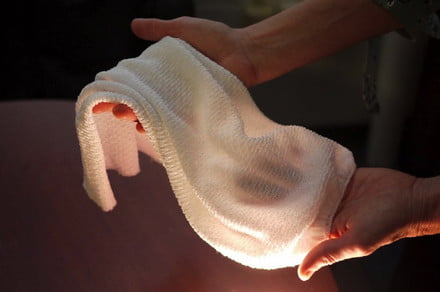Faye Levine, University of Maryland
Very few items of clothing will keep you the perfect temperature all the time. You might pull on your comfortingly thick coat to keep you warm in the winter, but go into a house where the heat is cranked up and you’ll be shedding it in no time. The same is true for that cool summer T-shirt, which leaves you uncomfortably chilly the moment someone switches on the AC. Could a smart material give us the best of both worlds?
A new fabric being developed by scientists at the University of Maryland certainly gives us hope. Described by its creators as the world’s first textile to automatically change its properties to either trap or release heat depending on conditions, it promises to keep us at the optimal temperature year-round.
“Just like an automated window blind, our fabric can adaptively regulate thermal radiation in response to your personal comfort,” YuHuang Wang, professor in the Department of Chemistry and Biochemistry at the University of Maryland, told Digital Trends. “We achieve this new functionality by engineering the fabric at the fiber level, making it a ‘switchable’ or dynamically responsive system.”
The yarn responsible for the new textile is created using fibers made of two different synthetic materials. One of these absorbs water, while the other one repels it. The strands are coated with conductive carbon nanotubes. As a result of materials in the fibers both resisting and absorbing water, they warp when exposed to humidity, such as a sweating body. This distortion opens pores in the fabric, creating a cooling effect. It also modifies the electromagnetic coupling between the carbon nanotubes in the coating — which either blocks or allows infrared radiation to travel through. Before people are even aware that they are getting too warm, their clothing will be cooling them down. If the person cools down too much, the same mechanism will trap in heat.
“Our fabric features self-powered, autonomous thermoregulation,” Wang said. “We think these unique features will be particularly attractive for runners, infants, and field workers, for example.”
The team is now working toward scaling up their production process prior to attempting to bring it to market. A research paper describing the project was recently published in the journal Science.
Editors’ Recommendations
- The best energy-efficient space heaters to keep you warm this winter
- Top-load vs. front-load washer: Which should you buy?
- What is an Instant Pot? Here’s everything you need to know
- ‘Fallout 76’: Everything you need to know
- The best Xbox One games you can get right now

